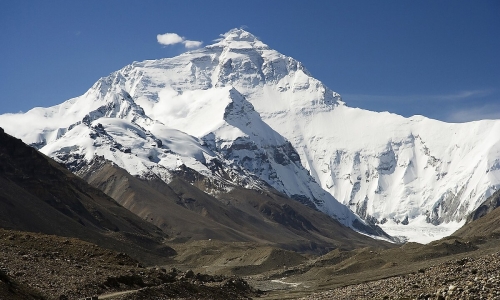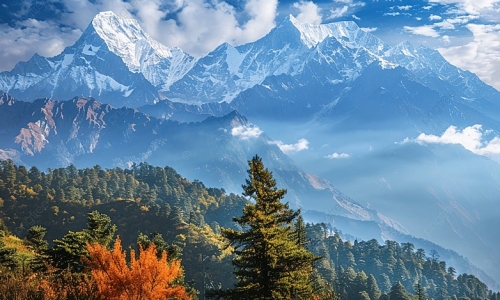On the majestic peaks of the Himalayas – where the sky seems closer to the human heart, where the white snow lies silently for thousands of years unchanged – there is an energy frequency that not everyone can feel, but whoever touches it will awaken. Himalayan Buddhism is not just a doctrine to be memorized, nor is it a ritual to be practiced in form. It is a journey back, back to oneself, to one's breath, to the original stillness that everyone once possessed, only to have lost it in the noisy pace of the world.
We often try to find peace outside ourselves: in success, in relationships, in work, in money. But true peace is always within, beneath the echoes of thought, beneath the layer of worries and anxieties.

Himalayan Buddhism is the path that helps us listen to ourselves.
The healing power of Himalayan Buddhism does not come from blind faith or unrealistic mysticism – but from the science of mind and energy, from how breath, meditation, awareness, and compassion can profoundly change human biology and psychology.
Chapter 1: The Origin and Source of Himalayan Energy
The Himalayas are not just the highest mountains in the world. They are a symbol of the purest vibration, a place where humans can feel the Earth's rhythm of breathing. For thousands of years, true practitioners have come here not to escape life, but to return to themselves.
In the Himalayas, humans are forced to face silence. No more city noise, no more daily worries, no more constant impacts from the outside world. Only the heartbeat, the breath, and the endless sky remain. And it is in this silence that the mind begins to settle down.
Many people think enlightenment is something supernatural. But in reality, enlightenment only happens when humans stop running away from their own minds.
The Himalayas are a very large mirror. It reflects everything we try to forget: old pain, deep wounds, desires, doubts, and even the yearning to be loved.
The masters in Himalayan Buddhism teach that:
- "When the mind is at peace, the mountains will speak for themselves. When the mind is chaotic, the mountains still stand there, only you cannot hear them."
- Why do the Himalayas have special energy?
- Modern science has begun to explain what the ancients have known for a long time:
- The Earth's electromagnetic field is stronger in high-altitude areas.
- The concentration of negative ions in the air in the Himalayas is very high, helping to stabilize emotions and reduce stress.
- The pristine natural environment reduces the overall neurological stimulation.
This leads to:
- The mind easily falls into a state of natural stillness.
- The brain shifts from stressful beta waves to deeply relaxing alpha and theta waves.
- From there, it opens up a state that meditation masters call absorption.
- The Himalayas – not a place to go to, but a state to return to
Not everyone can set foot in the Himalayas. But the true Himalayas lie within our own hearts. When we can slow down, we are returning to the Himalayas. When we stop chasing thoughts, we are returning to the Himalayas. When we realize that the path out is the path in – we have climbed to the top of the mountain.
The Himalayas are not outside. The Himalayas are waiting for you right in your breath.
Chapter 2: The Philosophy of Himalayan Buddhism in Modern Life
Himalayan Buddhism does not require people to leave life, abandon family, or run away from responsibility. On the contrary, the core of this philosophy is to live fully in life, but with a different consciousness — an awakened consciousness.
For those who are just beginning to touch meditation and healing, the most important message is:
Peace does not come from the outside. Peace is created from within you.
We often think that if we finish our work, if we have more money, if others understand us better, if our health is better… then we will be at peace. But peace is not the result of external conditions. Peace is an internal state, the way we face ourselves.
1. Mindfulness: The Root of Himalayan Buddhism
Mindfulness is not about trying to control thoughts. Mindfulness is observing thoughts without judgment. When you observe, thoughts will naturally subside, just like the surface of a lake stops rippling when the wind stops blowing.
Practicing mindfulness is simpler than you think:
- Inhale and know that you are inhaling.
- Exhale and know that you are exhaling.
- That's it. Don't try to fix it. Don't try to be better. Don't try to achieve anything.
- And it is in that moment — the mind begins to heal.
2. Living Slowly to See More Clearly
Modern life makes us accustomed to speed. We react quickly, answer quickly, decide quickly, consume information quickly — but do not have time to see ourselves.
Himalayan Buddhism teaches that:
If you want to see the mountain, you must stop.
When we slow down:
We realize that life is present in every breath.
We realize that the body has been tired for a long time but has never been rested.
We realize that the heart is calling out to be loved.
3. Love Begins with Yourself
Many people always try to love others a lot, but forget to take care of themselves. You cannot pour water from an empty glass. You can only give love when you are full.
Himalayan Buddhism reminds us:
- Become a safe haven for your own heart.
- When you know how to love yourself properly:
- Fear gradually disappears.
- Judgment decreases.
- Compassion naturally blossoms.
4. Applying Immediately in Daily Life
No need for high mountains, no need for temples, no need for monasteries. You can start right now:
When drinking water: drink with awareness.
When walking: step with lightness.
When listening to someone: listen with your heart.
When breathing: breathe as if embracing yourself.
Each small moment, repeated every day, will become the warmth that heals the inner self.
The Himalayas do not demand perfection. The Himalayas only invite you to return.
Chapter 3: The Encounter Between Modern Science and Himalayan Wisdom
For a long time, spirituality and science were seen as two separate worlds. Spirituality looks inward, science looks outward. Spirituality explores the self, science explores matter. But as science approached the edge of its limits, something strange happened: the two worlds began to meet.
Quantum physicists have discovered that matter does not exist in a fixed state. It fluctuates. It is dynamic. It reacts to the consciousness of the observer.
“Reality changes when consciousness changes.”
This coincides perfectly with the teachings of Himalayan Buddhism:
“The mind creates all things.”
1. The Brain, Breath, and State of Meditation
When a person falls into anxiety, stress, anger, or fear — the brain operates strongly in Beta waves. This is the state of living in reaction, in defense, in fight or flight.
But when a person goes into deep, slow, steady breathing — the brain waves shift to Alpha, then Theta and Delta.
- Alpha: Relaxation, creativity, peace.
- Theta: Healing, releasing memories.
- Delta: Restructuring the mind – body – energy.
That is, by simply adjusting the breath, we change the entire psychological and emotional state.
This is the gateway to healing of the Himalayas.
No medication. No need to believe. Just experience.
2. Cells Store Memories — And How Healing Happens
Research by Dr. Bruce Lipton (Cell Biology, Stanford University) shows:
The body does not only live by DNA,
But is also controlled by beliefs, emotions, and energy fields.
Psychological trauma is not only in the mind, but also imprinted in the cells.
Himalayan Buddhism heals by:
Softening the nervous system
Releasing blocked energy in the body (knots in the heart, chest, abdomen, throat...)
Bringing the mind back to a state of transparent awareness
When the mind is at peace, the body heals itself. When emotions dissolve, painful memories leave.
There is nothing mysterious. It's just that science hasn't named it long enough.
Chapter 4: The Human Being — 3 Layers That Need to Be Healed
1. The Body — where all experiences are stored
Every trauma we go through in life: fear, betrayed love, abandonment, feeling unacknowledged…
All of it is not lost. It is retained by the body, especially at:
- chest (difficulty breathing, heaviness)
- abdomen (lingering anxiety)
- shoulders and neck (responsibility and pressure)
lower back (feeling unsupported)
When healing, the body will release each layer. Not through analysis. But through direct feeling.
4.2. Qi — the bridge between body and mind
Qi flows → emotions flow. Qi is blocked → emotions are trapped.
That is why the more people suppress, the more they hurt. The more they run away from emotions, the more emotions haunt them.
Himalayan breath is the key to unlocking Qi.
4.3. The Mind — not thought, but the space of awareness
The biggest thing people misunderstand is:
Mind = thought.
No. Thought is just the activity of the mind.
The Mind is the sky.
Thoughts are just clouds.
Healing is returning to the sky, not trying to dispel the clouds.
Chapter 5: The Healing Experience — Not From Theory, But From Breath
Explaining is meaningless. Everything only truly happens when we close our eyes and return to our own breath.
“There is no path to the inside.
There is only returning.”
In the Himalayas, we are guided:
- Sit still
- Relax your shoulders, jaw, eyes, abdomen
- Inhale deeply — bring the air down to your abdomen
- Exhale slowly — release all force
That's it. But it is from here that the inner door opens.
Chapter 4: The Human Being — 3 Layers That Need to Be Healed
Every trauma we go through in life: fear, betrayed love, abandonment, feeling unacknowledged…
1. All of it is not lost. It is retained by the body, especially at:
- chest (difficulty breathing, heaviness)
- abdomen (lingering anxiety)
- shoulders and neck (responsibility and pressure)
- lower back (feeling unsupported)
When healing, the body will release each layer. Not through analysis. But through direct feeling.
.2. Qi — the bridge between body and mind
Qi flows → emotions flow. Qi is blocked → emotions are trapped.
That is why the more people suppress, the more they hurt. The more they run away from emotions, the more emotions haunt them.
Himalayan breath is the key to unlocking Qi.
3. The Mind — not thought, but the space of awareness
The biggest thing people misunderstand is:
Mind = thought.
No. Thought is just the activity of the mind.
The Mind is the sky.
Thoughts are just clouds.
Healing is returning to the sky, not trying to dispel the clouds.
Chapter 5: The Healing Experience — Not From Theory, But From Breath
Explaining is meaningless. Everything only truly happens when we close our eyes and return to our own breath.
“There is no path to the inside.
There is only returning.”
In the Himalayas, we are guided:
Sit still
Relax your shoulders, jaw, eyes, abdomen
Inhale deeply — bring the air down to your abdomen
Exhale slowly — release all force
That's it. But it is from here that the inner door opens.



















